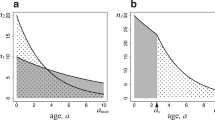Abstract
The mechanism underlying the regulation of the work performed by the members of a colony is a crucial factor in the colonial life of eusocial organisms. If the response thresholds of the workers vary, greater-than-chance variation in the prevalence of work-related behaviors (i.e., in the “working degree”) is expected, and the distribution of these behaviors should be reestablished after demographic changes. We show that greater-than-chance variation in the working degree is restored after a demographic change in the ant Myrmica kotokui. The working degree varied markedly among workers, and the degree of variation could not be explained by chance alone. Moreover, the degree of variation could not be attributed to intrinsic factors such as reproductive potential or age. After a demographic change, some previously inactive workers started to work, whereas some previously active workers became inactive. These shifts resulted in the restoration of a substantial amount of variation in the working degree. These observations all support the hypothesis that variance in the response threshold is the basis of the regulation of work-related behaviors in this ant.




Similar content being viewed by others
References
Altmann J (1974) Observational study of behavior: sampling methods. Behaviour 49:227–267
Blanchard GB, Orledge GM, Reynolds SE, Franks NR (2000) Division of labour and seasonality in the ant Leptotholax albipennis: worker corpulence and its influence on behavior. Anim Behav 59:723–738
Bonabeau E, Theraulaz G, Deneubourg JL (1996) Quantitative study of the fixed threshold model for the regulation of division of labour in insect societies. Proc R Soc Lond B 263:1565–1569
Crawley MJ (2002) Statistical computing: an introduction to data analysis using S-Plus. Wiley, Chichester
Dornhas A (2008) Specialization does not predict individual efficiency in an ant. PLoS Biol 6:1–8
Fewell JH, Bertram SM (1999) Division of labor in a dynamic environment: response by honeybee (Apis mellifera) to graded changes in colony pollen stores. Behav Ecol Sociobiol 46:171–179
Franks NR, Tofts C (1994) Foraging for work: how tasks allocate workers. Anim Behav 48:470–472
Hasegawa E (1993) Caste specialization in food strage in the dimorphic ant Colobopsisi nipponicus (Wheeler). Ins Soc 40:261–271
Herbers JM, Cunningum M (1983) Social organization in Leptothorax longispinosus Mayr. Anim Behav 31:759–771
Hölldobler B, Wilson EO (1990) The ants. Belknap Press of Harvard University Press, Cambridge
Jones JC, Myerscough MR, Graham S, Oldroyd BP (2004) Honey bee nest thermoregulation: diversity promotes stability. Science 305:402–404
Kikuchi T, Higashi S, Murakami T (1999) A morphological comparison of alates between monogynous and polygynous colonies Myrmica kotokui in northernmost Japan. Ins Soc 46:250–255
Korb J, Heinze J (2004) Multilevel selection and social evolution of insect societies. Naturwissenshaften 91:291–304
McDnald P, Topoff H (1985) Social regulation of behavioral development in the ant, Novomessor albisetosus (Mayr). J Comp Psychol 99:3–14
Meudec M, Lenoir A (1982) Social responses to variation in food supply and nest suitability in ants (Tapinoma erraticum). Anim Behav 30:384–292
Nakata K (1995) Age polyethism, idiosyncrasy and behavioral flexibility in the queenless ponerine ant, Diacamma sp. J Ethol 13:113–123
Oster GF, Wilson EO (1978) Caste and ecology of social insects. Princeton University Press, Princeton
Page RE, Erber J, Fondrk MK (1998) The effect of genotype on response thresholds to sucrose and foraging behavior of honey bees (Apis mellifera L.). J Comp Phsiol 182:489–500
Pankiw T, Page RE (2000) Response thresholds to sucrose predict foraging division of labor in honeybees. Behave Ecol Sociobiol 47:265–267
Ravary F, Lecoutey E, Kaminski G, Châline N, Jaisson P (2007) Individual experience alone can generate lasting division of labor in ants. Curr Biol 17:1308–1312
Robinson GE (1992) Regulation of division of labour in insect sociaeties. Ann Rev Entomol 37:637–665
Robinson GE, Page RE (1995) Genotypic constraints on plasticity for corpse removal in honey bee colonies. Anim Behav 49:867–876
Robinson EJH, Feinerman O, Franks NR (2009) Flexible task allocation and the organization of work in ants. Proc R Soc B 276:4373–4380
Sasaki T, Tsuji K (2003) Behavioral property of unusual large workers in the ant, Pristomyrmex pungens. J Ethol 21:145–151
Seeley TD (1989) The honey bee colony as a super organism. Am Sci 77:546–553
Sempo G, Detrain C (2010) Social task regulation in the dimorphic ant, Pheidole pallidula: the influence of caste ratio. J Insect Sci 10:1–16
Sokal RR, Rohlf FJ (1994) Biometry: the principles and practice of statistics in biological research. Freeman, New York
Theraulaz G, Bonabeau E, Deneubourg J (1998) Response threshold reinforcement and division of labour in insect societies. Proc R Soc Lond B 265:327–332
Tofts C, Franks NR (1992) Doing the right thing: ants, honeybees and naked mole-rats. TREE 7:346–349
Tripet F, Nonacs P (2004) Foraging for work and age-based polyethism: the roles of age and previous experience on task choice in ants. Ethology 110:863–877
Weidenmüller A (2004) The control of nest climate in bumblebee (Bombus terrestris) colonies: interindividual variability and self reinforcement in fanning response. Behave Ecol 15:120–128
Wilson EO (1971) The insect societies. Harvard University Press, Cambridge
Wilson EO (1976) Behavioral discretization and number of castes in an ant species. Behav Ecol Sociobiol 1:141–154
Wilson EO (1984) The relation between caste ratios and division of labor in the ant genus Pheidole (Hymenoptera; Formicidae). Behav Ecol Sociobiol 16:89–98
Wilson EO (1985) Between-caste aversion as a basis for division of labor in the ant Pheidole pubiventris (Hymenoptera; Formicidae). Behav Ecol Sociobiol 17:35–37
Winston ML, Katz SJ (1982) Foraging differences between cross-fostered honeybee workers (Apis mellifera) of European and Africanized races. Behav Ecol Sociobiol 10:125–129
Acknowledgments
We thank T. Kikuchi for information about sampling sites. K. Kobayashi and K. Tada are also acknowledged for assistance with field sampling. K. Tsuji provided helpful comments over the course of the study.
Author information
Authors and Affiliations
Corresponding author
About this article
Cite this article
Ishii, Y., Hasgeawa, E. The mechanism underlying the regulation of work-related behaviors in the monomorphic ant, Myrmica kotokui . J Ethol 31, 61–69 (2013). https://doi.org/10.1007/s10164-012-0349-6
Received:
Accepted:
Published:
Issue Date:
DOI: https://doi.org/10.1007/s10164-012-0349-6




